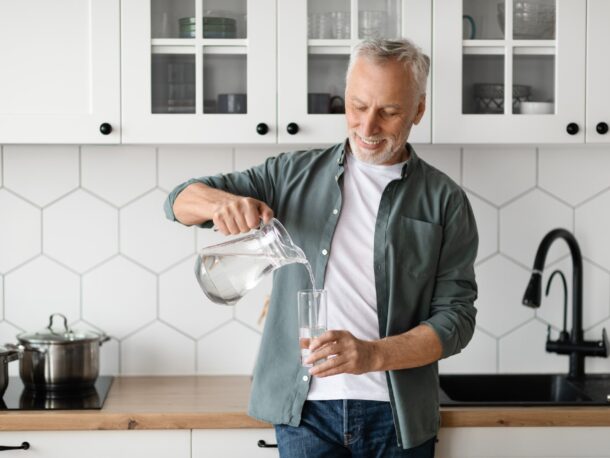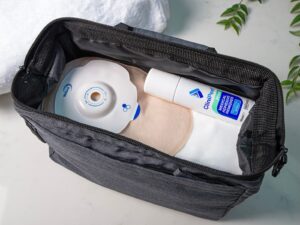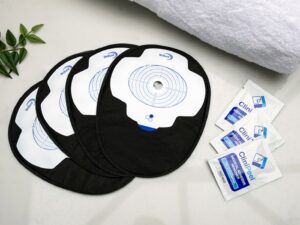Urinary incontinence is a term that describes accidental or involuntary loss of urine from the bladder. This can take the form of small leaks or a larger loss of bladder control.
A third of people living in the UK will experience incontinence at some point during their lifetimes. This common condition affects millions of individuals, of different ages, genders, and lifestyles and is nothing to be ashamed of.
There are a wide variety of treatments and management options available for people living with urinary incontinence. These range from medical and surgical interventions including medications and surgeries to products like catheters, sheaths and absorbent pads.

What does incontinence mean?
Urinary incontinence means a loss of control over urination, and it can significantly impact quality of life. While it’s often associated with ageing, it can affect people at any stage of life. Understanding the definition of incontinence is the first step towards getting the right support and treatment.
Types of incontinence
There are six main types of urinary incontinence, and they can occur for a variety of reasons. Sometimes, the causes may overlap. It’s important to speak with your Doctor, Healthcare Professional or Local Continence Service if you believe you may be experiencing symptoms, as the treatment for incontinence will vary depending on the type.
Urge incontinence
Urge incontinence, or overactive bladder, involves a sudden, intense need to urinate, often followed by leakage. This is typically caused by the detrusor muscles in the bladder wall contracting too frequently.
Stress incontinence
Stress incontinence is when urine leaks during physical activities that put pressure on the abdomen – such as sneezing, coughing, laughing or having sex. The main causes are age-related physiological changes and pelvic floor dysfunction.
Mixed urinary incontinence
Mixed incontinence refers to a combination of both urge and stress incontinence. It’s most commonly experienced by people after labour and birth of more than one child and is caused by a combination of both bladder and pelvic floor dysfunction.
Overflow incontinence
Overflow incontinence, or chronic urinary retention, occurs when the bladder cannot empty properly. This can lead to constant dribbling or leaking. If you have overflow incontinence you may feel the need to urinate frequently but only pass small amounts of urine or, struggle to pass any at all. Your bladder may feel like it’s always full. Overflow incontinence can be cause by a blockage or obstruction in the bladder, like an enlarged prostate, bladder stones or constipation, or by the detrusor muscles in the bladder not contracting enough.
Total incontinence
Total incontinence is when you’re unable to store any amount of urine in your bladder. It is usually caused by congenital birth defects, spinal cord injuries or a bladder fistula.
Functional incontinence
Functional incontinence is when people experience urinary incontinence because they are unable to get to a bathroom. This can be due to a variety of reasons, such as cognitive impairment, immobility, and individuals who are dependent on asking others to assist them with their toileting needs.
Treatment, management and medication for incontinence
There are several treatment options for urinary incontinence, depending on the type and underlying cause. These may include:
- Lifestyle changes, such as reducing caffeine or alcohol
- Pelvic floor exercises to strengthen muscles
- Medications that help control bladder contractions or reduce urgency
- Surgical procedures for more severe cases
- Continence products like pads, sheaths and catheters
Your healthcare provider can help you determine the most appropriate incontinence treatment for your needs.
Can urinary incontinence be prevented?
There is no guaranteed way to prevent urinary incontinence but there are steps you can take to reduce the risk of developing it.
Making changes to your diet may help you reduce the number of times you need to urinate. Caffeine, which can be commonly found in coffee, tea and some carbonated drinks, is a diuretic and can make you urinate more often.
Alcohol is also a diuretic and can disrupt the signals between your brain and bladder causing continence issues. Certain foods and drinks can irritate the bladder and make you urinate more often like milk, citrus fruits and tomatoes.
Practising pelvic floor exercises can help strengthen some of your muscles and reduce the risk of dysfunction.

Continence support and resources
Find lots of helpful tips for living with incontinence in our resource library.

Managing and Treating Incontinence
Learn about the different ways you can manage and treat incontinence and what products might work for you.

Nutrition Guide for Continence Patients
Written with dietitian Ruth Kander, this guide offers advice on what to include and avoid in your diet to support bladder health, reduce irritation, and manage incontinence.

Continence Hydration Guide
This guide created by healthcare specialists, offers practical tips, a daily fluid intake tracker, and a sample menu to help you stay on top of your hydration needs.

Bladder Diary
Our bladder diary allows you to track daily activities, fluid intake and bathroom visits, giving you valuable insights into your urinary patterns.


